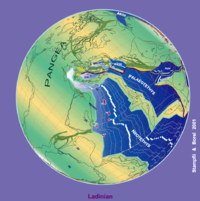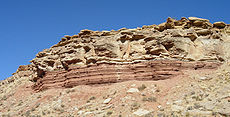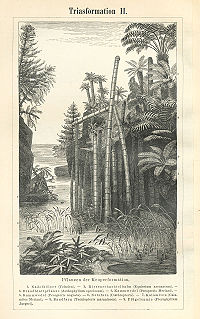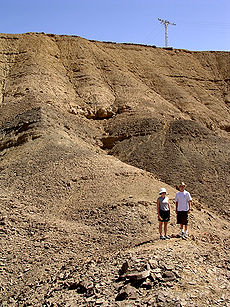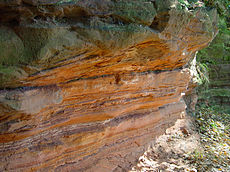
Triassic
About this schools Wikipedia selection
SOS Children has tried to make Wikipedia content more accessible by this schools selection. All children available for child sponsorship from SOS Children are looked after in a family home by the charity. Read more...
| Triassic Period 252.2–201.3 million years ago |
|
| 240px | |
| Mean atmospheric O2 content over period duration | ca. 16 Vol % (80 % of modern level) |
| Mean atmospheric CO2 content over period duration | ca. 1750 ppm (6 times pre-industrial level) |
| Mean surface temperature over period duration | ca. 17 °C (3 °C above modern level) |
|
Key events in the Triassic
view • discuss •
-255 —
–
-250 —
–
-245 —
–
-240 —
–
-235 —
–
-230 —
–
-225 —
–
-220 —
–
-215 —
–
-210 —
–
-205 —
–
-200 —
–
Mesozoic
Palæozoic An approximate timescale of key Triassic events.
Axis scale: millions of years ago. |
|
The Triassic is a geologic period and system that extends from about 251 to 199 Ma (million years ago). As the first period of the Mesozoic Era, the Triassic follows the Permian and is followed by the Jurassic. Both the start and end of the Triassic are marked by major extinction events. The extinction event that closed the Triassic period has recently been more accurately dated, but as with most older geologic periods, the rock beds that define the start and end are well identified, but the exact dates of the start and end of the period are uncertain by a few million years.
During the Triassic, both marine and continental life show an adaptive radiation beginning from the starkly impoverished biosphere that followed the Permian-Triassic extinction. Corals of the hexacorallia group made their first appearance. The first flowering plants ( Angiosperms) may have evolved during the Triassic, as did the first flying vertebrates, the pterosaurs.
Dating and subdivisions
The Triassic was named in 1834 by Friedrich Von Alberti from the three distinct layers (Latin trias meaning triad) — red beds, capped by chalk, followed by black shales— that are found throughout Germany and northwest Europe, called the 'Trias'.
The Triassic is usually separated into Early, Middle, and Late Triassic Epochs, and the corresponding rocks are referred to as Lower, Middle, or Upper Triassic. The faunal stages from the youngest to oldest are:
| Upper/Late Triassic (Tr3) | |
| Rhaetian | (203.6 ± 1.5 – 199.6 ± 0.6 Ma) |
| Norian | (216.5 ± 2.0 – 203.6 ± 1.5 Ma) |
| Carnian | (228.0 ± 2.0 – 216.5 ± 2.0 Ma) |
| Middle Triassic (Tr2) | |
| Ladinian | (237.0 ± 2.0 – 228.0 ± 2.0 Ma) |
| Anisian | (245.0 ± 1.5 – 237.0 ± 2.0 Ma) |
| Lower/Early Triassic (Scythian) | |
| Olenekian | (249.7 ± 0.7 – 245.0 ± 1.5 Ma) |
| Induan | (251.0 ± 0.4 – 249.7 ± 0.7 Ma) |
Paleogeography
During the Triassic, almost all the Earth's land mass was concentrated into a single supercontinent centered more or less on the equator, called Pangaea ("all the land"). From the east a vast gulf entered Pangaea, the Tethys sea. It opened farther westward in the mid-Triassic, at the expense of the shrinking Paleo-Tethys Ocean, an ocean that existed during the Paleozoic. The remaining shores were surrounded by the world-ocean known as Panthalassa ("all the sea"). All the deep-ocean sediments laid down during the Triassic have disappeared through subduction of oceanic plates; thus, very little is known of the Triassic open ocean. The supercontinent Pangaea was rifting during the Triassic—especially late in the period—but had not yet separated. The first nonmarine sediments in the rift that marks the initial break-up of Pangea—which separated New Jersey from Morocco—are of Late Triassic age; in the U.S., these thick sediments comprise the Newark Group. Because of the limited shoreline of one super-continental mass, Triassic marine deposits are globally relatively rare, despite their prominence in Western Europe, where the Triassic was first studied. In North America, for example, marine deposits are limited to a few exposures in the west. Thus Triassic stratigraphy is mostly based on organisms living in lagoons and hypersaline environments, such as Estheria crustaceans.
Climate
The Triassic climate was generally hot and dry, forming typical red bed sandstones and evaporites. There is no evidence of glaciation at or near either pole; in fact, the polar regions were apparently moist and temperate, a climate suitable for reptile-like creatures. Pangaea's large size limited the moderating effect of the global ocean; its continental climate was highly seasonal, with very hot summers and cold winters. It probably had strong, cross-equatorial monsoons.
Life
Three categories of organisms can be distinguished in the Triassic record: holdovers from the Permian-Triassic extinction, new groups which flourished briefly, and other new groups which went on to dominate the Mesozoic world.
In marine environments, new modern types of corals appeared in the Early Triassic, forming small patches of reefs of modest extent compared to the great reef systems of Devonian times or modern reefs. The shelled cephalopods called ammonites recovered, diversifying from a single line that survived the Permian extinction. The fish fauna was remarkably uniform, reflecting the fact that very few families survived the Permian extinction. There were also many types of marine reptiles. These included the Sauropterygia, which featured pachypleurosaurs and nothosaurs (both common during the Middle Triassic, especially in the Tethys region), placodonts, and the first plesiosaurs; the first of the lizardlike Thalattosauria ( askeptosaurs); and the highly successful ichthyosaurs, which appeared in Early Triassic seas and soon diversified, some eventually developing to huge size during the late Triassic.
On land, the holdover plants included the lycophytes, the dominant cycads, ginkgophyta (represented in modern times by Ginkgo biloba) and glossopterids. The spermatophytes, or seed plants came to dominate the terrestrial flora: in the northern hemisphere, conifers flourished. Glossopteris (a seed fern) was the dominant southern hemisphere tree during the Early Triassic period.
Temnospondyl amphibians were among those groups that survived the Permian-Triassic extinction, some lineages (e.g. Trematosaurs) flourishing briefly in the Early Triassic, while others (e.g. capitosaurs) remained successful throughout the whole period, or only came to prominence in the Late Triassic (e.g. plagiosaurs, metoposaurs). As for other amphibians, the first Lissamphibia are known from the Early Triassic, but the group as a whole did not become common until the Jurassic, when the temnospondyls had become very rare.
Archosauromorph reptiles — especially archosaurs — progressively replaced the synapsids that had dominated the Permian. Although Cynognathus was a characteristic top predator in earlier Triassic ( Olenekian and Anisian) Gondwana, and both kannemeyeriid dicynodonts and gomphodont cynodonts remained important herbivores during much of the period. By the end of the Triassic, synapsids played only bit parts. During the Carnian (early part of the Late Triassic), some advanced cynodont gave rise to the first mammals. At the same time the Ornithodira, which until then had been small and insignificant, evolved into pterosaurs and a variety of dinosaurs. The Crurotarsi were the other important archosaur clade, and during the Late Triassic these also reached the height of their diversity, with various groups including the phytosaurs, aetosaurs, several distinct lineages of Rauisuchia, and the first crocodylians (the Sphenosuchia). Meanwhile the stocky herbivorous rhynchosaurs and the small to medium-sized insectivorous or piscivorous Prolacertiformes were important basal archosauromorph groups throughout most of the Triassic.
Among other reptiles, the earliest turtles, like Proganochelys and Proterochersis, appeared during the Norian (middle of the Late Triassic). The Lepidosauromorpha—specifically the Sphenodontia—are first known in the fossil record a little earlier (during the Carnian). The Procolophonidae were an important group of small lizard-like herbivores.
Archosaurs were initially rarer than the therapsids which had dominated Permian terrestrial ecosystems, but they began to displace therapsids in the mid-Triassic. This "Triassic Takeover" may have contributed to the evolution of mammals by forcing the surviving therapsids and their mammaliform successors to live as small, mainly nocturnal insectivores; nocturnal life probably forced at least the mammaliforms to develop fur and higher metabolic rates.
Coal
When the Triassic commenced a coal hiatus (no coal) appeared simultaneously all over the world at the Permian-Triassic boundary Probably a sudden large drop in sea level permitted whatever caused the hiatus, and thus accounts for the sudden appearance, for at the close of the Permian there was an even quicker drop in sea level than the slower drop that had occurred in its last half, the sharpest in history . There had been many salt deposits in Permian basins in the last half . There are large salt basins in the southwest United States and a very large basin is suspected in central Canada, now eroded away . Possibly a tsunami opened up some of these basins, evaporation from which would have previously delayed the sea level decline, and thus account for that quicker drop at the end. This or something like this could account for a subsequent rapid rise when the inland sea created evaporated again after barriers were reestablished. Glaciers can be safely ruled out because there is no evidence of glaciers anywhere during the Triassic. Immediately above the boundary the glossopteris flora was suddenly largely displaced by an Australia wide coniferous flora containing few species and containing a lycopod herbaceous under story. Conifers became common in Eurasia also. Each of these groups of conifers arose from endemic species because conifers are very poor at crossing ocean barriers and they remained separated for hundreds of millions of years, largely to the present. Podocarpis was south and Pines, Junipers, and Sequoias were north, for instance. The dividing line ran through the Amazon Valley, across the Sahara, and north of Arabia, India, Thailand, and Australia . It has been suggested that there was a climate barrier for the conifers , although water barriers are more plausible. If so, something that can cross at least short water barriers must have been involved in producing the coal hiatus. Hot climate could have been an important auxiliary factor across Antarctica or the Bering Straights , however. There was a spike of fern and lycopod spores immediately after the close of the Permian . In addition there was also a spike of fungal spores immediately after the Permian-Triassic boundary . This spike may have lasted 50,000 years in Italy and 200,000 years in China and must have contributed to the climate warmth. If so, something besides an instant catastrophe must have been involved to cause the coal hiatus because fungi would surely have removed all dead vegetation and coal forming detritus in a few decades in most tropical places. Besides, the fungal spores rose gradually and declined similarly. There was also much woody debris. Each phenomenon would hint at widespread vegetative death. Whatever caused the coal hiatus must have started in North America 25 million years sooner . Weesner believes that Mastotermitidae termites may go back to the Permian and fossil wings have been discovered in the Permian of Kansas which have a close resemblance to wings of Mastotermes of the Mastotermitidae, which is the most primitive living termite and which is thought to be the descendant of Cryptocercus genus, the wood roach. This fossil is called Pycnoblattina. It folded its wings in a convex pattern between segments 1a and 2a. Mastotermes is the only living insect that does the same , so it is possible that they are responsible for the coal hiatus. This is plausible because termites attack the trunk, which is the most vulnerable part. Modern termites also eat detritus. If parasitoids were what brought back the coal after about 10 million years past the opening, their initial evolution must have taken place in or near Australia because the coal reappeared there first by several million years . Ancestors of the Evaniidae, which parasitize roach egg sacs , could have been the ones involved, and this may explain why termites evolved separated eggs except in Mastotermitidae. During the Triassic coal hiatus in the beginning of the Triassic it was possible to find stump impressions up to 45 cm (17.7 in) and root impressions up to 18 cm (7 in) in south Australia, but no roots or logs. The soil was extremely low in organic matter and there was no detritus at all .
Lagerstätten
The Monte San Giorgio lagerstätte, now in the Lake Lugano region of northern Italy and Switzerland, was in Triassic times a lagoon behind reefs with an anoxic bottom layer, so there were no scavengers and little turbulence to disturb fossilization, a situation that can be compared to the better-known Jurassic Solnhofen limestone lagerstätte. The remains of fish and various marine reptiles (including the common pachypleurosaur Neusticosaurus, and the bizarre long-necked archosauromorph Tanystropheus), along with some terrestrial forms like Ticinosuchus and Macrocnemus, have been recovered from this locality. All these fossils date from the Anisian/ Ladinian transition (about 237 million years ago).
Late Triassic extinction event
The Triassic period ended with a mass extinction, which was particularly severe in the oceans; the conodonts disappeared, and all the marine reptiles except ichthyosaurs and plesiosaurs. Invertebrates like brachiopods, gastropods, and molluscs were severely affected. In the oceans, 22% of marine families and possibly about half of marine genera went missing according to University of Chicago paleontologist Jack Sepkoski.
Though the end-Triassic extinction event was not equally devastating everywhere in terrestrial ecosystems, several important clades of Crurotarsi (large archosaurian reptiles previously grouped together as the thecodonts) disappeared, as did most of the large labyrinthodont amphibians, groups of small reptiles, and some synapsids (except for the proto-mammals). Some of the early, primitive dinosaurs also went extinct, but other more adaptive dinosaurs survived to evolve in the Jurassic. Surviving plants that went on to dominate the Mesozoic world included modern conifers and cycadeoids.
It is not certain what caused this Late Triassic extinction, which was accompanied by huge volcanic eruptions about 202 to 191 million years ago [(40Ar/39Ar dates)] known as the Central Atlantic Magmatic Province [(CAMP)], one of the largest inland recorded volcanic event since the planet cooled and stabilized, as the supercontinent Pangaea began to break apart. Other possible but less likely causes for the extinction events include global cooling or even a bolide impact, for which an impact crater surrounding Manicouagan Reservoir in Quebec, Canada, has been singled out. At the Manicouagan impact crater, however, recent research has shown that the impact melt within the crater has an age of 214±1 Ma. The date of the Triassic-Jurassic boundary has also been more accurately fixed recently, at 201.58±0.28 Ma. Both dates are gaining accuracy by using more accurate forms of radiometric dating, in particular the decay of uranium to lead in zircons formed at the impact. So the evidence suggests the Manicouagan impact preceded the end of the Triassic by approximately 10±2 Ma. Therefore it could not be the immediate cause of the observed mass extinction.
The number of Late Triassic extinctions is disputed. Some studies suggest that there are at least two periods of extinction towards the end of the Triassic, between 12 and 17 million years apart. But arguing against this is a recent study of North American faunas. In the Petrified Forest of northeast Arizona there is a unique sequence of latest Carnian-early Norian terrestrial sediments. An analysis in 2002 found no significant change in the paleoenvironment. Phytosaurs, the most common fossils there, experienced a change-over only at the genus level, and the number of species remained the same. Some Aetosaurs, the next most common tetrapods, and early dinosaurs, passed through unchanged. However, both Phytosaurs and Aetosaurs were among the groups of archosaur reptiles completely wiped out by the end-Triassic extinction event.
It seems likely then that there was some sort of end-Carnian extinction, when several herbivorous archosauromorph groups died out, while the large herbivorous therapsids— the kannemeyeriid dicynodonts and the traversodont cynodonts— were much reduced in the northern half of Pangaea ( Laurasia).
These extinctions within the Triassic and at its end allowed the dinosaurs to expand into many niches that had become unoccupied. Dinosaurs became increasingly dominant, abundant and diverse, and remained that way for the next 150 million years. The true "Age of Dinosaurs" is the Jurassic and Cretaceous, rather than the Triassic.

